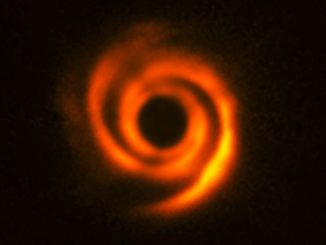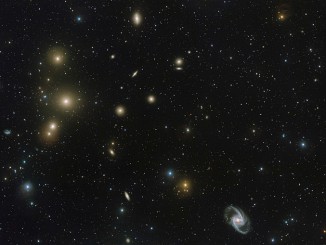
ESO’s Paranal Observatory


Best ever image of another star’s surface and atmosphere
Using ESO’s Very Large Telescope Interferometer astronomers have constructed the most detailed image ever of a star — the red supergiant star Antares. They have also made the first map of the velocities of material in the atmosphere of a star other than the Sun, revealing unexpected turbulence in Antares’s huge extended atmosphere.

Supermassive black holes feed on cosmic jellyfish
Observations of “Jellyfish galaxies” with ESO’s Very Large Telescope have revealed a previously unknown way to fuel supermassive black holes. It seems the mechanism that produces the tentacles of gas and newborn stars that give these galaxies their nickname also makes it possible for the gas to reach the central regions of the galaxies, feeding the black hole that lurks in each of them and causing it to shine brilliantly.

SPHERE reveals protoplanetary discs being shaped by newborn planets
Three teams of astronomers have made use of SPHERE, an advanced exoplanet-hunting instrument on the Very Large Telescope (VLT) at ESO’s Paranal Observatory, in order to shed light on the enigmatic evolution of fledgling planetary systems. The explosion in the number of known exoplanets in recent years has made the study of them one of the most dynamic fields in modern astronomy.

Eta Carinae star system revealed in unprecedented detail
An international team of astronomers have used the Very Large Telescope Interferometer to image the Eta Carinae star system in the greatest detail ever achieved. They found new and unexpected structures within the binary system, including in the area between the two stars where extremely high velocity stellar winds are colliding.

Remains of ancient globular clusters found at the heart of the Milky Way
Ancient variable stars, of a type known as RR Lyrae, have been discovered in the centre of the Milky Way for the first time. RR Lyrae stars typically reside in ancient stellar populations over 10 billion years old, such as globular clusters. These stars may even be the remains of the most massive and oldest surviving star cluster of the entire Milky Way.

ESO signs €400 million contract for E-ELT dome and 39-metre telescope structure
At a ceremony held today in Germany, the European Southern Observatory and the ACe Consortium signed the largest contract ever in ground-based astronomy for key components of the 39-metre aperture European Extremely Large Telescope (E-ELT). The 85-metre-diameter, 5000 tonne dome and telescope structure will take telescope engineering into new territory.

Three potentially habitable worlds found orbiting nearby ultra-cool dwarf star
Astronomers have discovered three planets orbiting an ultra-cool dwarf star just 40 light-years from Earth. These worlds have sizes and temperatures similar to those of Venus and Earth and are the best targets found so far for the search for life outside the solar system. They are the first planets ever discovered around such a tiny and dim star.

Gazing into the furnace: VST captures the Fornax Cluster
This new image from the VLT Survey Telescope (VST) at ESO’s Paranal Observatory in Chile captures a spectacular concentration of galaxies known as the Fornax Cluster, which can be found in the Southern Hemisphere constellation of Fornax (The Furnace). The cluster plays host to a menagerie of galaxies of all shapes and sizes, some of which are hiding secrets.

VLTI’s sharpest view ever of dusty disc around ageing star
The Very Large Telescope Interferometer at ESO’s Paranal Observatory in Chile has obtained the sharpest view ever of the dusty disc around an ageing star. For the first time such features can be compared to those around young stars — and they look surprisingly similar. It is even possible that a disc appearing at the end of a star’s life might also create a second generation of planets.
